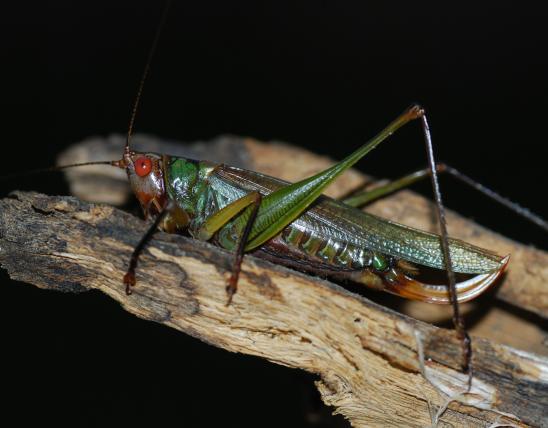
The fork-tailed bush katydid ranges throughout the Lower 48 and southern Canada. The color is usually leafy green, but different populations, in different regions, may have brownish, rusty, pinkish, or other casts — especially in autumn. If adults show any whitish mottling on the face, the white is usually not very sharply defined. The tegmina (the leathery forewings) are plain green, strongly resembling leaves (not streaked with black).
The call is a simple "tsip!" given every few seconds.
Females have an ovipositor—a curved, swordlike appendage at the tip of the abdomen — that is usually brownish or purplish.
Males in this genus are identified to species by a distinctively shaped plate in the tail area. Usually, the folded wings conceal this from casual view. Called a supra-anal plate, it is an extension on the top (dorsal) side of the last segment of the abdomen. The extension in this species is clearly two-lobed, shaped like a U, and rounded at the tips. It looks something like a horseshoe, and it is usually brownish or purplish. A subgenital plate, which looks something like the female’s ovipositor, curls from below and fits between the two forks of the supra-anal plate.
The fork-tailed bush katydid is one of about 250 species of katydids, also called long-horned meadow grasshoppers (family Tettigoniidae), in North America north of Mexico. They all have very long antennae, and many resemble green leaves.
Learn more about Missouri’s katydids on their group page.
Similar species: A close relative, the treetop bush katydid (S. fasciata), is very similar and confuses even specialists, but it lives in coniferous forests farther east; it does not occur in Missouri.
Adult length: about 1½ to 1¾ inches.
Statewide.
Habitat and Conservation
This species and others in genus Scudderia are called bush katydids because they are most common in bushes, thickets, and other shrubby areas. You may also find them in the margins of woodlands and overgrown fields.
Fork-tailed bush katydids are mostly nocturnal and may be attracted to lights at night. They are good fliers and hoppers.
If you want to find a fork-tailed bush katydid, go out after sunset and, as night falls, listen for its isolated, lone “tsip” sounds, made a few seconds apart. Cup your hands behind both ears and rotate like a sonar dish to zero in on the direction; advance slowly. Use a flashlight. If the katydid is hidden among green vegetation, it may be hard to see, but if it is perched on a tree trunk or other contrasting surface, like the side of a house, it is easier to locate.
Food
Fork-tailed bush katydids eat the foliage of a variety of shrubs and other plants.
Life Cycle
Like other members of order Orthoptera (including the crickets and grasshoppers), fork-tailed bush katydids have simple development, with no great difference between juvenile and adult forms. Immature individuals are smaller and lack wings.
As with other katydids, the female fork-tailed bush katydid has a rather scary-looking ovipositor (egg-laying appendage) at the tip of her abdomen. It looks like a flattened, curved knife or sword. These appendages are not harmful to humans. They are used only to deposit eggs.
In this species, the female slips her flattened ovipositor into the edge of a leaf and deposits one or a few eggs in the soft tissues between the top and bottom surfaces of the leaf, creating a swollen area, like a blister, along the outer part of the leaf. She repeats this process again and again on different leaves, laying up to about 175 eggs in her lifetime.
Human Connections
This species can be a pest when it occurs in large numbers in citrus groves and other orchards. If they chew on the rind of developing citrus fruits, it can disfigure the fruit and decrease salability. Generally, however, their populations are low enough not to cause serious problems with crops.
Katydids, including this species, have strong jaws and can give you a hearty nip. Handle with care.
It’s hard to imagine a late-summer night without the many sounds of katydids. Few people are aware of the diversity of insect singers that fill our summer days and nights with distinct, unique songs, as identifiable as the various bird songs.
Ecosystem Connections
This is what bird food looks like. Katydids are an important link in the food chain between plants and animals such as birds, reptiles, and many mammals, that hunt protein-rich, nutritious insects for a living. Insects that fly at night are hunted by bats.
Katydids are important food for great golden digger wasps. The mother wasps capture and paralyze katydids and crickets, fly or haul them to their burrows, then place them in the nest cells as food for their young.
































